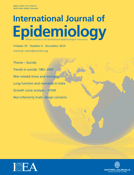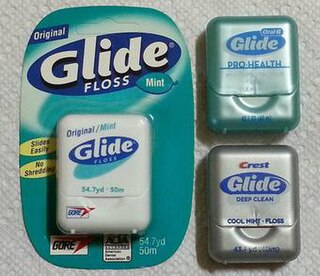Multiple chemical sensitivity (MCS) is an unrecognized and controversial diagnosis characterized by chronic symptoms attributed to exposure to low levels of commonly used chemicals. Symptoms are typically vague and non-specific. They may include fatigue, headaches, nausea, and dizziness.

An epidemic is the rapid spread of disease to a large number of hosts in a given population within a short period of time. For example, in meningococcal infections, an attack rate in excess of 15 cases per 100,000 people for two consecutive weeks is considered an epidemic.

Epidemiology is the study and analysis of the distribution, patterns and determinants of health and disease conditions in a defined population.

Environmental health is the branch of public health concerned with all aspects of the natural and built environment affecting human health. To effectively control factors that may affect health, the requirements that must be met to create a healthy environment must be determined. The major sub-disciplines of environmental health are environmental science, toxicology, environmental epidemiology, and environmental and occupational medicine.

Passive smoking is the inhalation of tobacco smoke, called passive smoke, secondhand smoke (SHS) or environmental tobacco smoke (ETS), by individuals other than the active smoker. It occurs when tobacco smoke diffuses into the surrounding atmosphere as an aerosol pollutant, which leads to its inhalation by nearby bystanders within the same environment. Exposure to secondhand tobacco smoke causes many of the same health effects caused by active smoking, although to a lower prevalence due to the reduced concentration of smoke that enters the airway.
An environmental factor, ecological factor or eco factor is any factor, abiotic or biotic, that influences living organisms. Abiotic factors include ambient temperature, amount of sunlight, air, soil, water and pH of the water soil in which an organism lives. Biotic factors would include the availability of food organisms and the presence of biological specificity, competitors, predators, and parasites.
Exposure assessment is a branch of environmental science and occupational hygiene that focuses on the processes that take place at the interface between the environment containing the contaminant of interest and the organism being considered. These are the final steps in the path to release an environmental contaminant, through transport to its effect in a biological system. It tries to measure how much of a contaminant can be absorbed by an exposed target organism, in what form, at what rate and how much of the absorbed amount is actually available to produce a biological effect. Although the same general concepts apply to other organisms, the overwhelming majority of applications of exposure assessment are concerned with human health, making it an important tool in public health.
Environmental epidemiology is a branch of epidemiology concerned with determining how environmental exposures impact human health. This field seeks to understand how various external risk factors may predispose to or protect against disease, illness, injury, developmental abnormalities, or death. These factors may be naturally occurring or may be introduced into environments where people live, work, and play.
Molecular epidemiology is a branch of epidemiology and medical science that focuses on the contribution of potential genetic and environmental risk factors, identified at the molecular level, to the etiology, distribution and prevention of disease within families and across populations. This field has emerged from the integration of molecular biology into traditional epidemiological research. Molecular epidemiology improves our understanding of the pathogenesis of disease by identifying specific pathways, molecules and genes that influence the risk of developing disease. More broadly, it seeks to establish understanding of how the interactions between genetic traits and environmental exposures result in disease.
Epidemiology is a bi-monthly, peer-reviewed journal for epidemiologic research, published by Lippincott Williams & Wilkins.

The International Journal of Epidemiology is a bimonthly peer-reviewed medical journal covering research in epidemiology. It is the official journal of the International Epidemiological Association and is published by Oxford University Press. The journal is a member of the Committee on Publication Ethics. The editor-in-chief is Stephen Leeder.
Genetic Epidemiology is a peer-reviewed medical journal for research on the genetic epidemiology of human traits in families and populations. It is published by John Wiley & Sons on behalf of the International Genetic Epidemiology Society.
Cancer Epidemiology, Biomarkers & Prevention is a peer-reviewed medical journal devoted to research in the field of cancer epidemiology. Topics include descriptive, analytical, biochemical, and molecular epidemiology, the use of biomarkers to study the neoplastic and preneoplastic processes in humans, chemoprevention and other types of prevention trials, and the role of behavioral factors in cancer etiology and prevention. It is published by the American Association for Cancer Research and co-sponsored by the American Society of Preventive Oncology.

Oral-B Glide is a PTFE (Teflon) dental floss manufactured by W. L. Gore and Associates exclusively for Procter & Gamble.
Theoretical Population Biology is a peer-reviewed scientific journal covering research on theoretical aspects population biology in its widest sense, including mathematical modelling of populations, ecology, evolution, genetics, demography, and epidemiology. The editor-in-chief is Noah A. Rosenberg, who in January 2013 succeeded the founding editor Marcus Feldman. The journal has a partnership with the journal Genetics, exchanging manuscripts in between the two if they are a better fit of the other journal's scope.
Epidemiologic Reviews is an annual peer-reviewed scientific journal covering epidemiology and published by Oxford University Press on behalf of the Johns Hopkins Bloomberg School of Public Health. The Journal was established in 1979 by Neal Nathanson and Philip E. Sartwell. The longest running editor-in-chief was Haroutune Armenian. The current editor-in-chief is David Celentano of the Johns Hopkins Bloomberg School of Public Health.
Community Dentistry and Oral Epidemiology is a bimonthly peer-reviewed medical journal covering dental public health and the application of epidemiology to dentistry. It was established in 1973 and is published by John Wiley & Sons. The editor-in-chief is Professor Sarah R Baker. According to the Journal Citation Reports, the journal has a 2020 impact factor of 3.383, ranking it 26th out of 91 journals in the category "Dentistry, Oral Surgery & Medicine" and 69th out of 203 in the category "Public, Environmental & Occupational Health".
The International Society for Environmental Epidemiology (ISEE) is a scientific society with membership drawn from more than 60 countries, dedicated to the study of environmental epidemiology and exposure assessment. It provides a forum for the discussion of problems unique to the study of health and the environment. The primary objective of ISEE is to promote research and disseminate scientific findings focused on the relationships between environmental exposures and human health. Each year, ISEE puts a spotlight on global discussion of environmental health and gathers scientists from all over the world to discuss measuring harmful factors in the environment including environmental health after disasters, e-waste, endocrine disrupting chemicals affecting pregnancy, and more. These include annual meetings, newsletters, workshops and liaisons with academic, governmental, inter-governmental, non-profit and business institutions.
The International Society of Exposure Science (ISES), is a non-profit organization established in 1990 by a group of scientists and engineers, including Paul Lioy. The formation of this society was at least partially in response to a National Research Committee (NRC) on Exposure Assessment that held a series of meetings and workshops beginning in 1987 that formed the foundation of exposure science and defined basic principles. The expertise of members in ISES is interdisciplinary and draws upon a broad array of disciplines, including: exposure assessment; biochemistry; risk assessment; bioinformatics; physiology; toxicology; epidemiology; ecology; environmental chemistry; and environmental engineering. The Society’s membership is professionally diverse and includes academic, governmental, and private sector scientists, as well as policy makers who have a common interest in exposure science. ISES has operated with a President, President-elect, Treasurer, and Secretary as well as Councilors. Councilors are elected from the membership and are allocated from the various professional categories that represent Society membership. The first set of Bylaws was approved by the membership in 1991.

Roel Vermeulen is a Dutch scientist and professor of Environmental epidemiology and Exposome Science at the Institute for Risk Assessment Sciences at Utrecht University and the Julius Centre for Health Sciences and Primary Care at the University Medical Center Utrecht, the Netherlands. In 2024 Prof. Vermeulen was appointed as Distinguished University Professor of Utrecht University in which role he will focus on the theme of planetary and preventive health.





